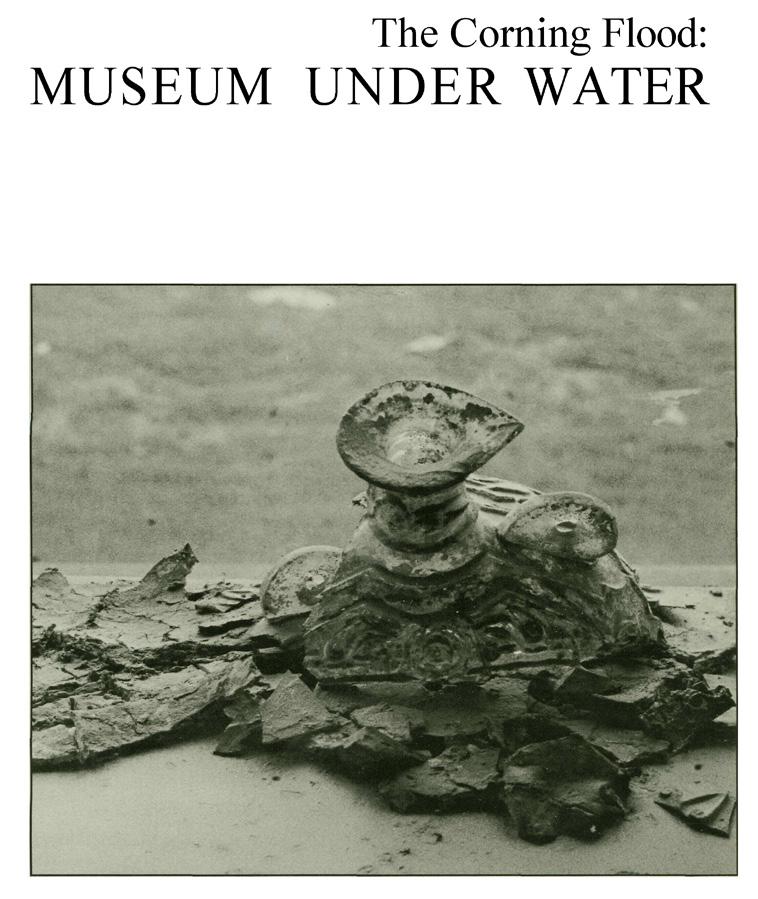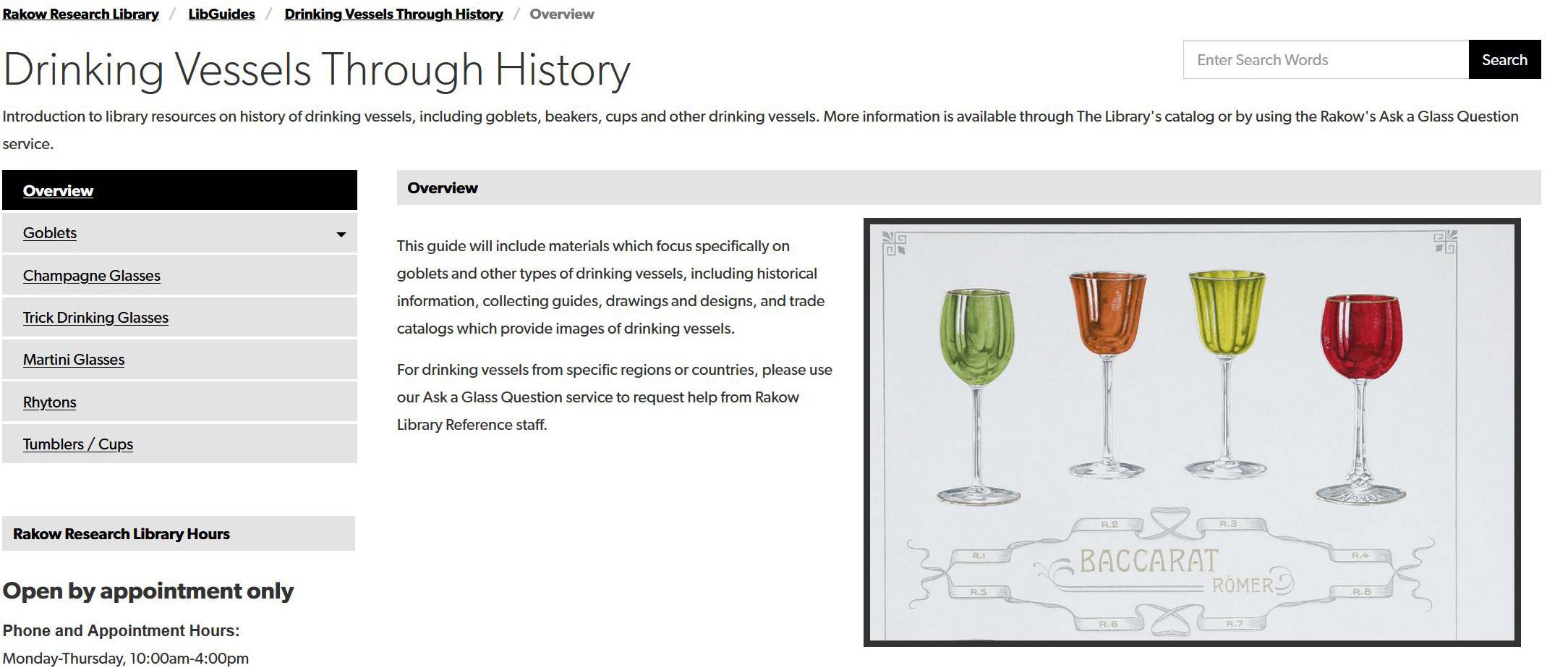
6 minute read
Moving Past Mud and Masks: Advancing Through Crises
by Regan Brumagen
If you had been in Corning, New York, on June 23, 1972, you would have witnessed a shocking moment in the history of The Corning Museum of Glass: Hurricane Agnes caused massive flooding that submerged much of the Museum and Rakow Research Library collections. The water shattered glass objects and left books, drawings, photos, and magazines caked in mud. The Museum closed for 39 days. When you look at pictures from “The Flood,” as locals refer to it, it’s astonishing that the Museum was able to re-open to the public that quickly.
Next year will be the 50th anniversary of The Flood and I’m struck by how an event that brought such hardship also led us to re-think our practices and re-focus on our priorities. The Flood of ’72 prompted many changes, such as a greatly improved disaster recovery program, new science in paper conservation, and, for The Rakow Library, a move to leveraging technology to improve preservation and access to our collections.
It was after the disaster that staff began a rigorous program of microfilming our unique collections, such as rare books and trade catalogs. Okay, if you’ve ever used microfilm, you know it’s a lot clunkier than looking at a digitized book on Google, but at the time, it allowed library staff to send our materials to people around the world who otherwise would have needed to travel to Corning for the same information. Microfilm was a big deal then---it even had its own celebration week (September 24-30 was National Microfilm Week in 1972.) Did you know that the precursor to New Glass Review, entitled Contemporary Glass, was published on microfiche only?
During the Agnes recovery process, the Museum committed to another new service that changed library access for good. In 1975, our institution joined the Online Computer Library Center (OCLC), a collaborative project to collect the holdings of libraries worldwide in order to more efficiently catalog and share resources among institutions. We were the first museum library in the United States to join this “catalog of library catalogs.” Today, OCLC is an essential part of almost every library’s process for interlibrary loan. But you can use it, too. Want to find out which libraries have copies of Antonio Neri’s The Art of Glass? Go to https://worldcat.org. Not only can you see which libraries around the world have the publications you want, but you can ask your local library to borrow a copy on your behalf.
I’ve been thinking of The Library’s postflood efforts to preserve our collections and improve accessibility to them in relation to our activities this past year. In March 2020, our Museum and Library temporarily closed again, as the world struggled to slow the spread of Covid-19. During this closure, we didn’t undertake a massive reformatting project (like the amazing microfilm), but we did take the opportunity to explore services that would help connect our communities with our staff and collections during a period of global and individual isolation.

Left: Read the remarkable story of the flood and recovery in Museum Under Water: https://www.cmog.org/ Right: Contemporary Glass 1977 morphed into New Glass Review after three years of being published on microfiche. Photo Credit: The Corning Museum of Glass
Allie Shanafelter, Reference Librarian, monitoring Chat at the Rakow Library. Photo credit: The Corning Museum of Glass


One of our more popular online research guides introduces visitors to research on the history of drinking vessels. Photo Credit: The Corning Museum of Glass.
In addition to offering two new virtual reference services, chat and online consultations, we are now members of an important cooperative, Social Networks and Archival Context (more easily remembered as SNAC) that, like OCLC before it, seeks to use the collaborative power of cultural heritage institutions like libraries, museums and archives to make research easier. SNAC describes people, companies, and institutions who have created, are subjects of, or are referenced in archival materials, including collections of artist files. SNAC facilitates searches across the collections of repositories, freeing the researcher from obscure footnotes and random websites. Although SNAC is in its infancy, you can see how the Erwin Eisch record (https:// snaccooperative.org/view/35521994) leverages Eisch’s own artistic network to help researchers locate archival materials about him.
We are also strengthening the online content we offer on our own website through continued development of Ask a Glass Question (https://libanswers. cmog.org) and our online research guides (https://libguides.cmog.org).
Here’s a rundown of ways you can connect with us:
Ask a Glass Question: Even while we were closed, we continued to receive questions through our online reference service, Ask a Glass Question. In fact, the number of questions we received increased during the pandemic. This service includes a searchable database of frequently asked questions (FAQs) and answers on glass topics. Curious about the origins of the term “glory hole”? You aren’t the only one! It’s one of our more frequently viewed glass FAQs (https://libanswers.cmog.org/ faq/144299).
Chat with a Librarian: Our new chat services are available four hours a day during open hours as an alternative to a phone call. And unlike some chat services on commercial websites, we promise you will not be connected to a robot---although we may exhibit signs of robotic behavior if we haven’t yet had our coffee.
Consult a Librarian: In order to provide assistance to those with more in-depth research needs, we now offer 30 minute appointments (via video or phone call) so you can talk with a reference librarian about the best ways to research your topic (https://reserve.cmog.org).
Donate: One way to connect with us is to help strengthen our collections on the art, craft, history, and early technologies of glass and glassmaking through either a financial donation (https://give.cmog.org/ form/donate) or a donation of materials (general books, magazines, videos, etc.: librarydonations@cmog.org; rare and unique materials (books, letters, records, catalogs, etc.): archives@cmog.org).
Glass Subject Guides: We continue to maintain and expand on our online guides, providing overviews of topics from the history of glass to glassmaking techniques. For instance, check out our popular guide on Drinking Vessels through History with new sections on Rhytons and Tumblers (https://libguides.cmog.org/drinkingvessels).
Interlibrary Loan: Remember OCLC? We are still a member along with more than 15,000 libraries in over 100 countries. Through OCLC, we continue to lend and copy materials for patrons worldwide. During 2020, we were among a relatively small number of libraries who kept interlibrary loan services available. Primo: The Library’s catalog has come a long way, and Primo is our state-of-the-art discovery system. Our Library holdings remain the largest on the subject of glass worldwide. Primo lets you search our collections and find and access digitized materials, including hundreds of design drawings and trade catalogs (https:// rakow.cmog.org).
Studio Reserves: We now offer a new online reserve system to support our Studio instructors and students. If you are taking a course at The Studio, you may find digitized library materials relating to your class for you to read, print or download. We’re also in the process of developing a physical “Studio Reserves” collection in The Library to ensure that core texts are always available to Studio students, even if we’ve lent our other copy to you through Interlibrary Loan!
Given travel restrictions and the closures of many museums, libraries, and archives, our goal has been to provide our communities with new ways to reach us and use our collections from a distance. Don’t expect our services to disappear when travel restrictions ease, however; we recognize that for many, traveling to Corning to conduct research is impractical even without a pandemic in force.
You hear the phrase “adapting to the new normal” a lot these days. For us that means continually exploring ways to increase access to our collections and to create new opportunities to connect with all of you.
Regan Brumagen is the Manager of Reference and Access Services at the Rakow Library.










